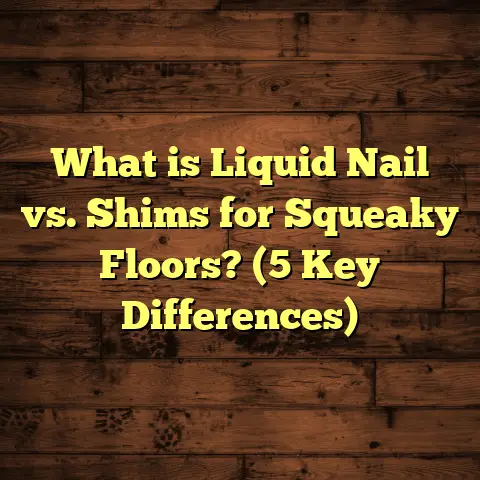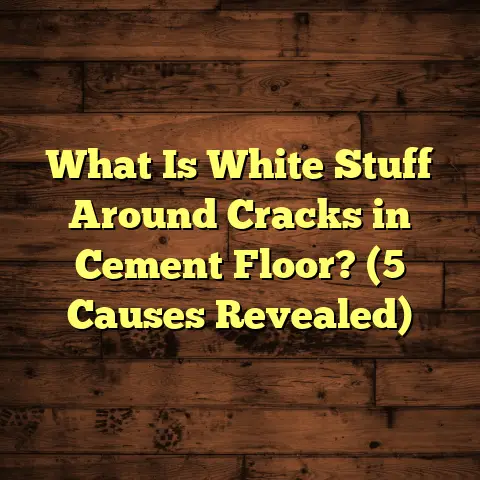What is Trending for Kitchen Floors? (5 Stunning Styles Revealed)
Eco-Friendly Choices Are Shaping Kitchen Flooring Trends
I’ve noticed a big shift among homeowners and designers toward eco-conscious decisions in kitchen flooring. More people want floors that not only look good but are also kind to the environment. This isn’t just a fad; it’s a lifestyle change. Choosing sustainable materials, reducing waste, and picking long-lasting options are becoming top priorities.
In my years working with clients on kitchen remodels, I’ve seen firsthand how these green choices reflect in their flooring picks. It’s exciting to see how style and sustainability can go hand in hand. You might wonder, how does this affect the actual materials and styles that are trending? Well, let me take you through what I’ve observed.
Because the kitchen is one of the busiest rooms in any home, the flooring has to handle a lot—spills, heavy foot traffic, dropped utensils, and even pet paws. So, finding floors that can withstand all of that without needing constant replacement fits perfectly with eco-conscious values. After all, durability means less waste.
What Is Trending for Kitchen Floors?
When we talk about trending kitchen floors, we’re really asking: what styles, materials, and designs are homeowners choosing right now? It’s about finding floors that blend beauty, function, and durability — all while fitting into today’s eco-aware mindset.
From my experience, trends don’t just come from aesthetics. They’re shaped by lifestyle needs, technological advances in materials, and growing environmental awareness too.
I’m going to share five styles that have been gaining serious momentum lately. Each has a distinct personality but shares qualities that make them perfect for kitchens today. I’ll also share personal stories from my installations and the research I’ve gathered along the way.
1. Reclaimed Wood Flooring: Rustic Charm with a Green Heart
Why I Love It
Reclaimed wood floors bring character and history into a kitchen. I’ve installed them in several homes where clients wanted something unique and sustainable. The wood is salvaged from old barns, factories, or warehouses, which means less demand for new lumber.
Installing reclaimed wood has been one of my favorite projects. One client had an old family barn that was being torn down. They wanted to preserve the wood in their new kitchen floor. We milled the planks and restored them carefully. The result? A floor with warmth and stories embedded in every knot and crack.
What Makes It Special?
- Eco Impact: Using reclaimed wood reduces deforestation significantly. According to the Environmental Protection Agency (EPA), sustainable wood sourcing helps lower carbon emissions by up to 30% compared to traditional lumber harvesting.
- Durability: Old-growth wood is denser and harder than most modern lumber because trees grew slower decades ago.
- Aesthetic: Each plank tells a story with its knots, grain patterns, and wear marks that no new floor can replicate.
- Unique Texture: The texture of reclaimed wood is often rougher and more tactile than new hardwoods, adding personality to your kitchen.
How It Works in Your Kitchen
Reclaimed wood floors are not just about looks; they handle kitchen challenges well once sealed properly. I always recommend applying a water-resistant finish like polyurethane or natural oils designed for kitchen use. This protects against spills and stains while preserving the wood’s character.
Tips from My Experience
- Preparation is Key: Reclaimed wood needs to be treated for pests or mold before installation.
- Expect Variation: Don’t expect every plank to be perfect or uniform—this adds to the charm.
- Allow for Movement: Older wood can expand or contract differently than new materials; proper acclimation before installation helps prevent warping.
- Maintenance Routine: Reclaimed floors benefit from occasional refinishing every 5-10 years depending on wear.
Data Point
A survey by the National Wood Flooring Association found reclaimed wood sales increased by 25% over the last five years, driven largely by eco-conscious buyers wanting authentic materials with history.
Case Study: The Barnwood Kitchen
One project I worked on involved transforming reclaimed barnwood into kitchen floors and cabinetry panels. The owners loved having a piece of their family history in their home. Plus, they felt great knowing they were reducing waste by repurposing material others might discard.
2. Porcelain Tile That Mimics Natural Stone
What’s Trending?
Porcelain tile has always been practical for kitchens due to its water resistance and durability. But now, tiles mimicking natural stone like marble or slate are stealing the spotlight.
I remember a client who loved marble’s elegance but dreaded the upkeep. We chose porcelain tiles with a marble pattern that looked stunning and required zero sealing or special cleaners.
Why It Works
- Low Maintenance: Unlike real stone, porcelain doesn’t need sealing or special cleaners.
- Durability: It stands up to heavy foot traffic and spills without scratching.
- Eco-Friendly Options: Many manufacturers now produce porcelain tiles using recycled materials and energy-efficient processes.
- Design Variety: Porcelain can replicate everything from matte slate to glossy marble with great detail.
- Resistant to Stains and Chemicals: Ideal for kitchens where acidic foods like lemon juice or vinegar might spill.
My Take
Porcelain tile is a win-win: you get luxury looks with practicality. The range of finishes makes it easy to match any kitchen style—from rustic farmhouse to sleek modern.
Practical Tip: Installation
Porcelain tile installation requires a level subfloor and professional grouting to prevent cracks over time. I always suggest using epoxy grout for better stain resistance in kitchens.
Stats You’ll Want to Know
The Tile Council of North America reports porcelain tile sales have grown steadily by 7% annually over the past five years. Environmental certifications like GREENGUARD are increasingly common among top brands, ensuring low chemical emissions.
Case Study: Marble Look Without Marble Price
In one renovation, a client wanted the elegance of Carrara marble but was concerned about staining and their budget. Porcelain tile offered a near-identical look for less than half the cost plus minimal maintenance. They were thrilled with how easy it is to keep clean after cooking big family meals.
3. Bamboo Flooring: Fast-Growing and Fabulous
Why Bamboo?
I’ve always recommended bamboo for clients who want hardwood-style floors with less environmental impact. Bamboo matures in about 5 years compared to decades for hardwood trees.
One family with two toddlers chose bamboo because they wanted something hardwearing but green-friendly. After four years of daily chaos—spilled juice, dropped toys—the floor still looked great.
What I’ve Learned Installing Bamboo
- Sustainability: Bamboo is highly renewable when harvested responsibly.
- Hardness: Strand-woven bamboo is harder than many hardwoods like oak or maple.
- Style Variety: It comes in natural tones as well as carbonized shades ranging from light honey to deep brown.
- Moisture Sensitivity: Bamboo can be vulnerable to humidity fluctuations unless properly sealed.
Installation Tips That Matter
I always advise clients to install a moisture barrier beneath bamboo flooring in kitchens since water spills are common. Also, acclimate the planks for several days before installation to reduce warping risk.
Maintenance Made Simple
Dust mop regularly and clean spills immediately. Use gentle cleaners formulated for bamboo or hardwood floors to maintain finish longevity.
Supporting Data
According to the World Bamboo Organization, global demand for bamboo flooring has increased by 15% per year due to its eco-friendly profile.
What About Cost?
Bamboo flooring generally costs between $5 – $11 per square foot installed. It’s often more affordable than traditional hardwood while giving a comparable look.
Case Study: Urban Bamboo Kitchen
A client living in a city loft wanted a warm floor that could handle moisture from cooking but was tired of synthetic vinyl options. We chose strand-woven bamboo finished with a waterproof sealant. Four years later it’s still holding up beautifully with minimal signs of wear.
4. Luxury Vinyl Plank (LVP) with Waterproof Technology
Why This Is Hot Right Now
LVP has been popular for years but has gotten even better with waterproof features that make it ideal for kitchens where spills happen often.
I recently installed LVP in a home with two dogs and three kids—the floors took everything from muddy paws to pasta sauce without damage or warping.
What Makes It Stand Out?
- Waterproof: No warping or swelling from moisture.
- Realistic Looks: Modern printing techniques replicate wood and stone textures incredibly well.
- Budget-Friendly: Costs about 30-50% less than hardwood or natural stone.
- Comfort Underfoot: Softer than tile or hardwood which is great if you spend hours cooking.
- Easy To Clean: Just sweep or mop with mild cleaner.
My Personal Experience
I installed waterproof LVP in a busy family kitchen where durability was non-negotiable. The clients love how easy it is to clean and how it holds up against their crazy schedule of cooking and entertaining.
Installation Insights
LVP installs faster than many other floors due to click-lock systems or glue-down options. DIYers appreciate this convenience but I recommend professional installation for best results on uneven subfloors.
Market Insight
The global waterproof vinyl flooring market is projected to grow by 8% annually over the next five years, signaling rising consumer trust in this material.
What Makes Today’s LVP Different?
Today’s LVP is far more durable than older versions. It resists scratches better, feels more authentic underfoot thanks to embossed textures, and often contains recycled content aligning with eco goals.
5. Terrazzo: Old School Meets Modern Chic
What’s the Appeal?
Terrazzo is making a huge comeback, blending colorful chips of marble, quartz, or glass set in cement or resin bases.
I recently worked on a mid-century modern remodel where terrazzo floors were original but badly worn. We restored them instead of replacing—a perfect example of sustainable renovation.
Why I Recommend Terrazzo
- Longevity: Terrazzo can last over 40 years with proper care.
- Sustainability: It often incorporates recycled materials.
- Customizable Design: You can create playful patterns or subtle textures tailored to your kitchen style.
- Cool Underfoot: Great for warmer climates as it doesn’t retain heat.
- Low Maintenance: Requires sealing every few years; simple cleaning routines keep it looking fresh.
My Story
I worked on a project using terrazzo with glass chips recycled from bottles. The final look was stunning and sparked conversations every time guests visited.
Data Point
Research from the Marble Institute shows terrazzo flooring reduces environmental impact by up to 60% compared to traditional concrete floors due to recycled content.
Practical Advice
Terrazzo can be cold and hard underfoot—adding area rugs or cushioned mats near sinks can help comfort during meal prep times.
Bringing It All Together: How to Choose Your Kitchen Floor Today
You might be wondering: with all these options, how do I pick what really fits my kitchen?
Here’s what I suggest based on what I’ve learned:
- Think About Your Lifestyle: Kids? Pets? Heavy cooking? That will influence durability and maintenance needs.
- Set Your Budget Wisely: While reclaimed wood or terrazzo might come with higher upfront costs, they offer long-term value.
- Check Eco Credentials: Look for certifications like FSC (Forest Stewardship Council) for wood or GREENGUARD for tiles.
- Test Samples at Home: Lighting can change how floors look dramatically.
- Work With Experienced Installers: Proper installation affects longevity and appearance more than you might expect.
- Consider Resale Value: Floors that balance style and durability bring better ROI when selling your home.
A Closer Look at Costs: What Should You Expect?
| Flooring Type | Average Cost per Sq Ft (Material + Installation) | Lifespan (Years) | Maintenance Level |
|---|---|---|---|
| Reclaimed Wood | $8 – $15 | 30+ | Medium (resealing) |
| Porcelain Tile | $7 – $12 | 25+ | Low |
| Bamboo | $5 – $11 | 20+ | Medium |
| Waterproof LVP | $3 – $7 | 15+ | Low |
| Terrazzo | $15 – $30 | 40+ | Low-Medium |
These numbers come from multiple industry sources including FloorTally estimates, helping homeowners plan smarter budgets.
What I’ve Learned From Real Projects: Insights From My Flooring Installations
Over the past decade working as a flooring contractor specializing in kitchens, I’ve noticed some patterns:
- Clients eager about sustainability tend to pick bamboo or reclaimed wood despite higher initial costs because they want greener choices.
- Families with young kids gravitate toward waterproof LVP because it’s forgiving and easy to clean.
- Designers love porcelain tile mimics because they bring luxury looks without long-term maintenance headaches.
- Terrazzo appeals most to those who want statement floors that last decades — perfect for high-end builds.
Each project taught me one thing clearly: no one-size-fits-all solution exists. The “best” floor fits your day-to-day life and your values.
Final Thought
Picking kitchen flooring is more than just choosing what looks good—it’s about matching your home’s energy and your values. When clients select floors that fit their lifestyle and their eco-conscious goals, they’re happier long-term with their choice.
So which style are you leaning toward? Are you drawn to rustic reclaimed wood or sleek porcelain tile? Or maybe you want something innovative like waterproof vinyl or classic terrazzo? Whatever you choose, making an informed choice will turn your kitchen floor from just functional into something truly special.
If you want help planning your project budget or picking materials tailored to your needs, tools like FloorTally can provide accurate cost estimates based on local labor rates and material prices — saving you time and guesswork.





